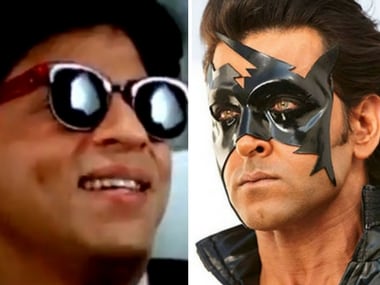From Space Oddity to Modern Love: The essential David Bowie playlist
Long before alter egos and wild outfits became commonplace in pop music, David Bowie turned the music world upside down with his flair and extravagance. He was a pop chameleon who won legions of fans with his ground-breaking, genre-defying music. His use of sound and visuals was nothing short of revolutionary as he reinvented himself with nearly every album, something no one else was doing at the time.

David Bowie performs on stage during a concert in Vienna in 1996.
Sadly, following an 18-month battle with cancer, the legend passed away two years ago on 10 January, 2016. So, what better way to celebrate his genius than with a playlist that captures the boundary-pushing essence of a kindred pop music spirit.
'Space Oddity' (David Bowie, 1969)
Bowie became a solo singer-songwriter emerging from the shadows of numerous bands he was part of during the 60s. 'Space Oddity', the opening track of his self-titled studio album, marked the beginning of a glorious career. Bowie was hardly 22 at the time and had timed its original release to coincide with the Apollo 11 Moon mission. After a barely audible but gorgeous instrumental build-up, Bowie's folk ballad tells the tale of a fictional astronaut named Major Tom who is seemingly stranded in infinite space touching on themes of alienation.
'The Man Who Sold the World' (The Man Who Sold the World, 1970)
Before it was famously covered by Nirvana in MTV Unplugged in New York, this Lovecraft-ian sci-fi ballad — with a title inspired by Robert A Heinlein's novella The Man Who Sold the Moon — talks about a man's mysterious encounter with his doppelganger as the dialogue shifts back and forth between them. In the title track of his this album, Bowie explores themes of duality and multiple personalities and our search for personal unity.
'Life on Mars?' (Hunky Dory, 1971)
His first major album, The Man Who Sold the World (1970), a hybrid of folk, art rock, and heavy metal, did not turn him into a household name. Not until Hunky Dory did he hit on the notion of presenting his chameleon-like stage persona as an identity rather than the lack of one. 'Life on Mars' is potentially the best track on the album as Bowie describes his state of despair living in a material world and grappling with his new-found fame. It is a bittersweet chamber-pop ballad that perfectly our innate desire to transcend the tedious human experience.
'Oh! You Pretty Things' (Hunky Dory, 1971)
The second track on Hunky Dory, 'Oh! You Pretty Things' begins with a catchy refrain reminiscent of Paul McCartney. Bowie's chamber pop piano ballad envisions a future where humans have "gotta make way for the Homo Superior", a concept similar to Friedrich Nietzsche's Ubermensch, where humanity transcends the limits of human existence and attains a higher state of consciousness.
'Andy Warhol' (Hunky Dory, 1971)
Bowie wrote about one of his early and contemporary influences, the American pop artist Andy Warhol, in an acoustic track that is a kaleidoscopic celebration of the '60s high-art demigod with flamenco guitars.
'Starman' (The Rise and Fall of Ziggy Stardust and the Spiders from Mars, 1972)
With the release of the 1972 album, The Rise and Fall of Ziggy Stardust and the Spiders from Mars introduced us to one of music’s most famous personas: Ziggy Stardust. Bowie's fifth studio album imagined a alien rock star from outer space trying to make his way in the earthly music world hoping to give a sense of hope five years before its impending doom. Starman was Bowie's first major hit since Space Oddity and introduced the world to Ziggy Stardust.
'Ziggy Stardust' (The Rise and Fall of Ziggy Stardust and the Spiders from Mars, 1972)
The signature track of Bowie's signature character, 'Ziggy Stardust' lists out Ziggy's various skills and talents. The iconic glam-rock anthem has since become one of the most beloved Bowie songs with its effervescent guitar riffs and catchy chorus. Bowie's Ziggy persona — the red-headed, eyeliner wearing Stardust — would become an enduring part of Bowie’s legacy, and a touchstone for the way entertainers packaged themselves for years to come.
'Suffragette City' (The Rise and Fall of Ziggy Stardust and the Spiders from Mars, 1972)
With A Clockwork Orange-inspired lyrics and Little Richard-inspired piano riffs and an indelible saxophone section, Bowie wrote what has since become a rock standard.
'Diamond Dogs' (Diamond Dogs, 1974)
The title track of the 1974 post-apocalyptic concept album introduced Bowie fans to a new persona, Halloween Jack. Bowie had one foot firmly planted in the glam scene and the other one looking to the future when he recorded Diamond Dogs. This is especially apparent in the track's final verse: "In the year of the scavenger, the season of the bitch / Sashay on the boardwalk, scurry to the Ditch / Just another future song, lonely little kitsch / There's gonna be sorrow / Try and wake up tomorrow." When one listens to the guitar work in the track, you can also hear the manifest The Rolling Stones influence.
'Young Americans' (Young Americans, 1975)
Bowie's 1975 single, "Young Americans" was a breakthrough hit for the British artist in America. Recorded in Philadelphia, Bowie worked with the great jazz saxophonist, David Sanborn. Aided by a samba-like beat, the song became one of his biggest hits and saw him transition from Ziggy Stardust to the Thin White Duke.
'Ashes to Ashes' (Scary Monsters, 1980)
Eleven years since 'Space Oddity,' Major Tom has turned into a "junkie, strung out in heaven's high, hitting an all-time low" in the lead single from Bowie's 14th studio album. The track combines four multi-tracked guitar synthesizers with a funky bass line.
'Modern Love' (Let's Dance, 1983)
The opening track to Bowie's immensely successful 1983 album, Let's Dance, 'Modern Love' chronicles the struggle between humanity and divinity: "God and Man no confessions / God and Man no religion / God and Man don't believe / in Modern Love." It was used perfectly by Noah Baumbach in Frances Ha where Greta Gerwig’s titular heroine sprints and dances freely through the busy streets of Manhattan while Bowie sings of knowing “when to go out” and “when to stay in.”
Published Date: Jan 10, 2018 17:07 PM | Updated Date: Jan 10, 2018 17:14 PM











